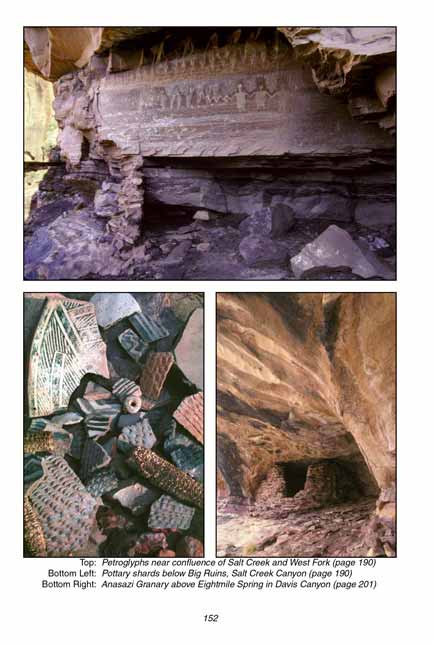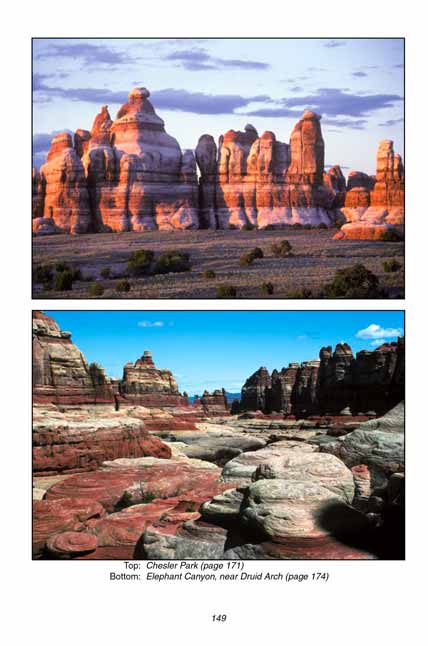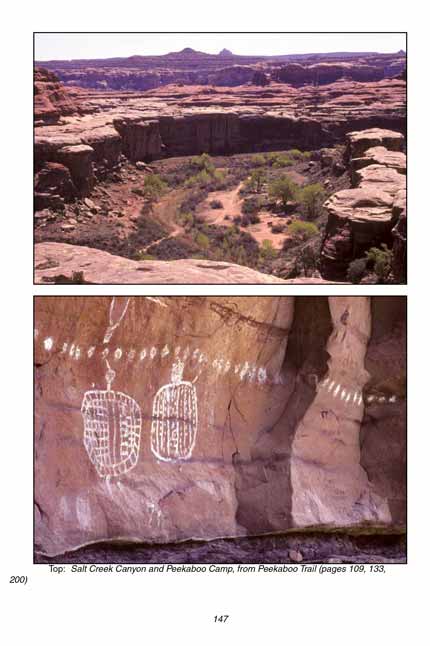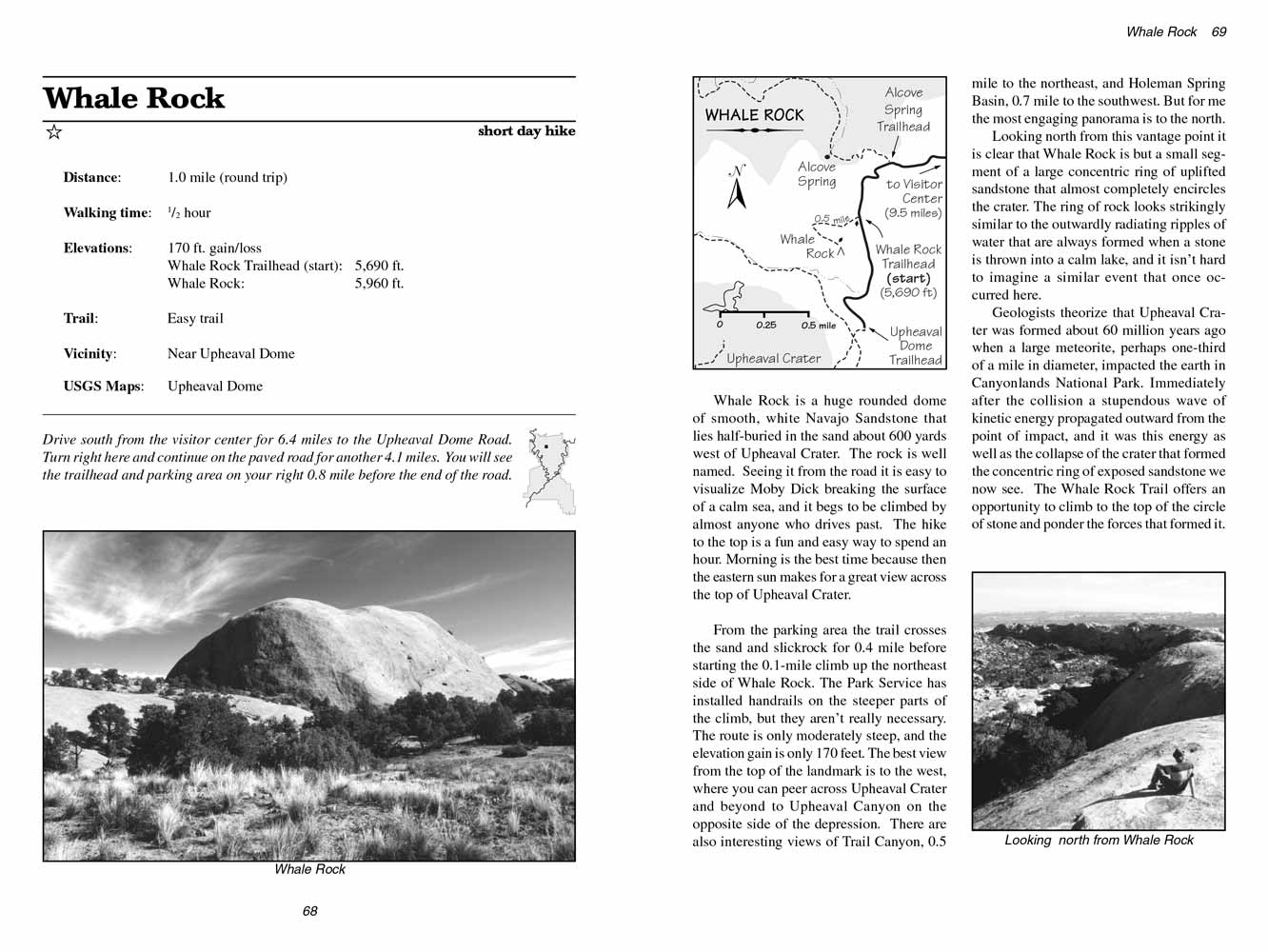Whale Rock Trail
excerpted from our book
Canyonlands National Park
Favorite Jeep Roads & Hiking Trails
pages 68-69
|
Buy book directly from the author!
Canyonlands National Park
Favorite Jeep Roads & Hiking Trails
- has access info for 75 trailheads
- 56 detailed trail maps
- 241 photographs
- loads of driving and hiking tips
|
regularly $14.95
now on sale for only
$11.95
click here
for book orders
|



 Whale Rock is a huge rounded dome of smooth, white Navajo Sandstone that lies half-buried in the sand about 600 yards west of Upheaval
Crater. The rock is well named. Seeing it from the road it is easy to visualize Moby Dick breaking the surface of a calm sea, and it begs to be
climbed by almost anyone who drives past. The hike to the top of Whale Rock is a fun and easy way to spend an hour. Morning is the best time because then the
eastern sun makes for a great view across the top of Upheaval Crater.
Whale Rock is a huge rounded dome of smooth, white Navajo Sandstone that lies half-buried in the sand about 600 yards west of Upheaval
Crater. The rock is well named. Seeing it from the road it is easy to visualize Moby Dick breaking the surface of a calm sea, and it begs to be
climbed by almost anyone who drives past. The hike to the top of Whale Rock is a fun and easy way to spend an hour. Morning is the best time because then the
eastern sun makes for a great view across the top of Upheaval Crater.
From the parking area the Whale Rock trail crosses the sand and slickrock for 0.4 mile before starting the 0.1-mile climb up the northeast side of Whale Rock. The
Park Service has installed handrails on the steeper parts of the climb, but they arenít really necessary. The route is only moderately steep, and the
elevation gain is only 170 feet. The best view from the top of Whale Rock is to the west, where you can peer across Upheaval Crater and beyond to
Upheaval Canyon on the opposite side of the depression. There are also interesting views of Trail Canyon, 0.5 mile to the northeast, and Holeman
Spring Basin, 0.7 mile to the southwest. But for me the most engaging panorama is to the north.
Looking north from this vantage point it is clear that Whale Rock is but a small segment of a large concentric ring of uplifted sandstone that almost
completely encircles the crater. The ring of rock looks strikingly similar to the outwardly radiating ripples of water that are always formed when a
stone is thrown into a calm lake, and it isnít hard to imagine a similar event that once occurred here.
Geologists theorize that Upheaval Crater was formed about 60 million years ago when a large meteorite, perhaps one-third of a mile in diameter, impacted
the earth in Canyonlands National Park. Immediately after the collision a stupendous wave of kinetic energy propagated outward from the point of impact,
and it was this energy as well as the collapse of the crater that formed the concentric ring of exposed sandstone we now see. The Whale Rock Trail
offers an opportunity to climb to the top of the circle of stone and ponder the forces that formed it.
Note to web developers: You may copy this material onto your site, but in return please include a link to my home page
www.utahtrails.com. Thank you, David Day (utahdavidday at gmail.com)
Click here to see more trails in
Canyonlands National Park
© Rincon Publishing Company, all rights reserved
|



 Whale Rock is a huge rounded dome of smooth, white Navajo Sandstone that lies half-buried in the sand about 600 yards west of Upheaval
Crater. The rock is well named. Seeing it from the road it is easy to visualize Moby Dick breaking the surface of a calm sea, and it begs to be
climbed by almost anyone who drives past. The hike to the top of Whale Rock is a fun and easy way to spend an hour. Morning is the best time because then the
eastern sun makes for a great view across the top of Upheaval Crater.
Whale Rock is a huge rounded dome of smooth, white Navajo Sandstone that lies half-buried in the sand about 600 yards west of Upheaval
Crater. The rock is well named. Seeing it from the road it is easy to visualize Moby Dick breaking the surface of a calm sea, and it begs to be
climbed by almost anyone who drives past. The hike to the top of Whale Rock is a fun and easy way to spend an hour. Morning is the best time because then the
eastern sun makes for a great view across the top of Upheaval Crater.